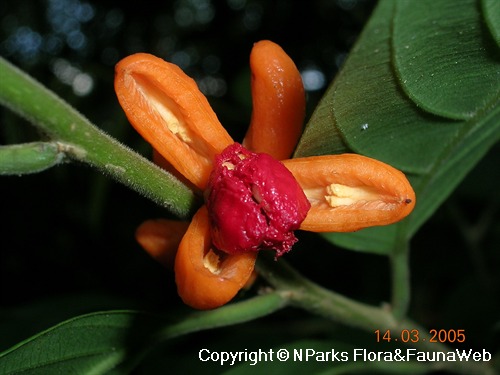
Back
Casearia capitellata Blume
| Family Name: | Salicaceae |
| Synonyms: | Casearia borneensis Merr., Casearia latifolia Ridl. |
Name
Classifications and Characteristics
| Plant Division | Angiosperms (Flowering Seed Plants) (Dicotyledon) |
|---|---|
| Plant Growth Form | Tree (Shrubby (1m-5m)), Shrub |
| Lifespan (in Singapore) | Perennial |
| Mode of Nutrition | Autotrophic |
| Plant Shape | Irregular |
| Maximum Height | 4 m |
Biogeography
| Native Distribution | Sumatra, Peninsular Malaysia, Singapore, and Borneo |
|---|---|
| Native Habitat | Terrestrial (Primary Rainforest) |
| Preferred Climate Zone | Tropical |
| Local Conservation Status | Native to Singapore (Critically Endangered (CR)) |
Description and Ethnobotany
| Growth Form | It is a shrub or tree up to 4 m tall. |
|---|---|
| Foliage | Its alternate, stalked leaves have thinly leathery leaf blades that are flexuous, shiny on both surfaces, oval-oblong to oval-egg-shaped, 10–20 by 4.5–10 cm, and with entire margins. |
| Flowers | Its flowering shoots are found in bundles at the leaf axils. They bear many white to pale green flowers. |
| Fruit | Its short-stalked fruits are ovoid-ellipsoid, turning yellow to orange when ripe, 1.5–2 by 1 cm, and found in bundles of 2–3 together. Each fruit contains few seeds. |
| Habitat | It grows in hill forests up to 500 m altitude. It occurs locally along Chestnut Avenue and in Upper Seletar Reservoir forest. |
| Associated Fauna | Its flowers are insect-pollinated. |
| Cultivation | It can be propagated by seed. |
| Etymology | Latin casearia, commemorating Father J. Casearius (d. 1678), a scholar and resident of Cochin; Latin capitellatus, having a small head, the reference to which is unknown |
Landscaping Features
| Landscaping | It may be suitable for parks. |
|---|---|
| Desirable Plant Features | Ornamental Fruits |
| Landscape Uses | General, Parks & Gardens, Small Gardens |
Fauna, Pollination and Dispersal
| Pollination Method(s) | Biotic (Fauna) |
|---|---|
| Seed or Spore Dispersal | Biotic (Fauna) |
Plant Care and Propagation
| Light Preference | Full Sun |
|---|---|
| Water Preference | Moderate Water |
| Plant Growth Rate | Moderate |
| Rootzone Tolerance | Moist Soils, Well-Drained Soils, Fertile Loamy Soils |
| Maintenance Requirements | Moderate |
| Propagation Method | Seed |
Foliar
| Foliage Retention | Evergreen |
|---|---|
| Mature Foliage Colour(s) | Green |
| Mature Foliage Texture(s) | Leathery, Thin |
| Foliar Type | Simple / Unifoliate |
| Foliar Arrangement Along Stem | Alternate |
| Foliar Attachment to Stem | Petiolate |
| Foliar Shape(s) | Non-Palm Foliage (Oval, Elliptical, Oblong) |
| Foliar Venation | Pinnate / Net |
| Foliar Margin | Entire |
| Leaf Area Index (LAI) for Green Plot Ratio | 3.0 (Tree - Intermediate Canopy) |
Floral (Angiosperm)
| Flower & Plant Sexuality | Bisexual Flowers |
| Flower Colour(s) | Green - Light Green, White |
|---|---|
| Flower Grouping | Cluster / Inflorescence |
| Flower Location | Axillary |
Fruit, Seed and Spore
| Mature Fruit Colour(s) | Orange |
|---|---|
| Fruit Classification | Simple Fruit |
Image Repository
Others
| Master ID | 1493 |
|---|---|
| Species ID | 2786 |
| Flora Disclaimer | The information in this website has been compiled from reliable sources, such as reference works on medicinal plants. It is not a substitute for medical advice or treatment and NParks does not purport to provide any medical advice. Readers should always consult his/her physician before using or consuming a plant for medicinal purposes. |


_lowres.jpg)